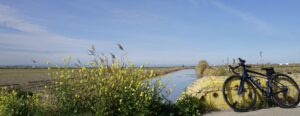We’re running low on provisions, so Friday 24 February has to be a shopping day. We found a small supermarket in Sollana and decided to make the most of the good weather with a bike riding afternoon, starting at the Muntanyeta dels Sants, a limestone outcrop visible for miles around as it stands just 27m above the flat expanse of rice fields beyond the Albufera lake. A 14th century chapel was built on the top and there’s a picnic area below the rocks. Two huge motorhomes were parked up when we arrived and, on enquiry, the German occupants said they’d been there two nights, so that’s tonight’s overnight sorted and the shopping done! Our bike ride meandered around the rice fields and it became quite chilly, so we returned to the starting point, put on some warmer clothes and climbed up to the chapel to watch the sunset.
A third of all rice in Spain is produced in Albufera. One of the largest rice-producing areas in Spain it is also one of the most important wetlands in Europe. The scenery is a fantastic mix of farming and wildlife amongst the sand dunes, lagoon, rice fields and irrigation canals. Rice has been grown here for more than a thousand years with 120 million kg. of rice produced annually in the 14,100 hectares of La Albufera Nature Reserve. Farmlands, paths, channels and ditches cover 70% of the total protected area. Rice farmers use specialist tractors and harvesters and mange the irrigation systems which criss cross the area. The fields are fertilised in February and flooded in April when the rice seedlings are set, planted in straight lines by hand. During the summer months the fields are hoed and the rice is harvested in September. Each farmer’s area is known as a ‘Tancat’, passed from father to son, with the water originally being managed by steam engines, hence the remaining chimneys although most engines are now electric.
















